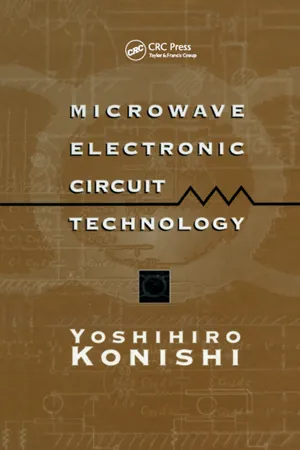
This is a test
- 432 pages
- English
- ePUB (mobile friendly)
- Available on iOS & Android
eBook - ePub
Microwave Electronic Circuit Technology
Book details
Book preview
Table of contents
Citations
About This Book
Provides a grounding in the physics behind the operational principles of high frequency technologies. The text presents up-to-date methods, as well as the research and developments of more efficient devices for use in applications, from mobile and satellite communications and wireless Local Area Networks to energy transformation and sensors. Examples and theories support the material.
Frequently asked questions
At the moment all of our mobile-responsive ePub books are available to download via the app. Most of our PDFs are also available to download and we're working on making the final remaining ones downloadable now. Learn more here.
Both plans give you full access to the library and all of Perlego’s features. The only differences are the price and subscription period: With the annual plan you’ll save around 30% compared to 12 months on the monthly plan.
We are an online textbook subscription service, where you can get access to an entire online library for less than the price of a single book per month. With over 1 million books across 1000+ topics, we’ve got you covered! Learn more here.
Look out for the read-aloud symbol on your next book to see if you can listen to it. The read-aloud tool reads text aloud for you, highlighting the text as it is being read. You can pause it, speed it up and slow it down. Learn more here.
Yes, you can access Microwave Electronic Circuit Technology by Yoshihiro Konishi in PDF and/or ePUB format, as well as other popular books in Technology & Engineering & Electrical Engineering & Telecommunications. We have over one million books available in our catalogue for you to explore.
Information
1
Basic Knowledge of Guided Waves
1TYPICAL WAVEGUIDES AND MODES
The construction of typical waveguides, the applications, and the characteristics are summarized in Fig. 1. The applications of the waveguides and modes shown in Fig. 1 are as follows:
(a)The parallel wire line is used for power lines, telephone lines, and a VHS TV feeder. In a high frequency, transmission loss is increased by radiation.
(b)The coaxial line is used from low frequency to microwave because there is no radiation loss.
(c)The strip line is used for small devices because it has no radiation loss and thin construction.
(d)The microstrip line is used in low-frequency to millimeter wave components because it is easily made on a substrate as a planar circuit.
(e)The waveguide is used for microwave and millimeter wave devices because it has small loss and is available to high power.
(f)The ridge waveguide is available to the lower frequency of microwave and small-sized components.
The electric and magnetic fields of Figs, 1a–1d exist...
Table of contents
- Cover
- Half Title
- Title Page
- Copyright Page
- Preface
- Table of Contents
- 1. Basic Knowledge of Guided Waves
- 2. Basic Knowledge of Microwave Network Theory
- 3. Basic Network Characteristics of a Transmission Line
- 4. Principle of Electromagnetic Resonators
- 5. Principle of Filters
- 6. Principle of Practical Circuits
- 7. Practical Applications on Systems
- Appendix 1: Introduction to Group Velocity
- Appendix 2: Cavity and Waveguide Perturbation
- Appendix 3: Relationships Among External Q, Qe, Coupling Coefficient, k, and g Values in BPF
- Appendix 4: Determination of Capacitances of the Uniform Coupled Lines in the Anisotropic Inhomogeneous Medium by Resistive Sheet
- Appendix 5: Design of Power Divider with Two Different Output Powers
- Appendix 6: Principle of Directional Coupler with Two Symmetrical Planes
- Appendix 7: Faraday Rotation in an Infinite Medium
- Index